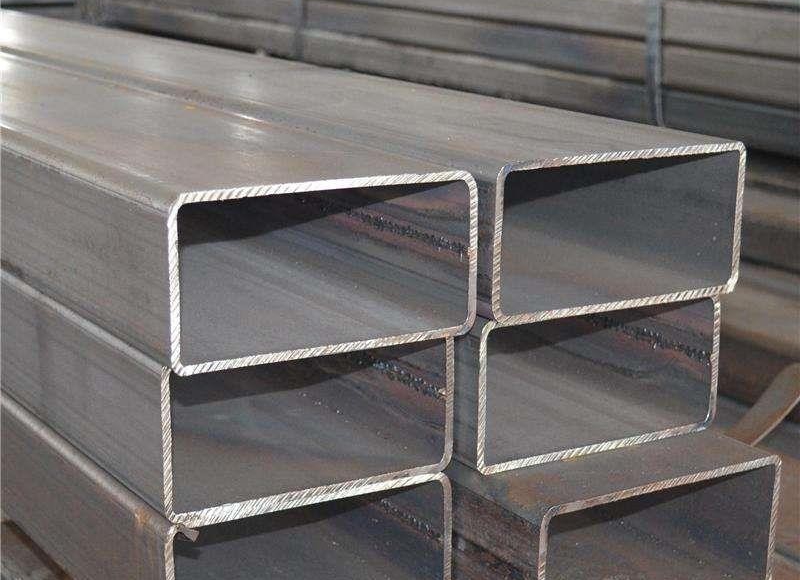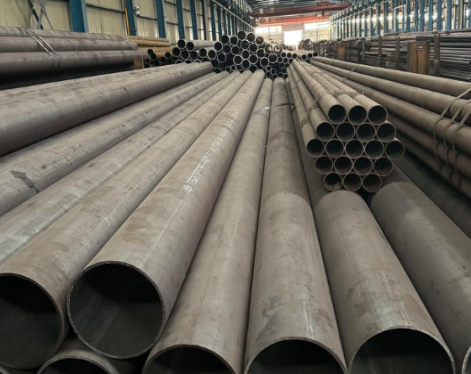Rectangular tube, also known as square tube or rectangular tube, is a kind of square steel with a hollow section. At present, there are two main forming processes for square tubes, which are the round-to-square and the direct-to-square.
Round-to-square
The forming process is to gradually roll the hot-rolled steel coil into a round tube or directly roll a seamless round tube through a multi-frame forming unit at room temperature.The round tube is then rolled into a square tube by a shaping unit, which is called the indirect squaring process or the round squaring process.
Advantages and disadvantages
The products formed by round and square are of good quality and the unit is fast in forming. For example, the inner angle R is equal, the welding seam is flat, and the product appearance is good.However, the square and rectangular tubes rolled by this process will expose their inherent defects.Since the force of the roll during the bending process of this process is always concentrated at one point, the internal stress is concentrated. If the internal stress is not relieved in a specific way, micro-cracks will often appear during the bending process of thick-walled profiles, which may lead to cracking in severe cases. Products with such defects have serious consequences for building steel structures.

Direct-to-square.
The main method of direct squaring is "bending", and there are two basic methods of bending: solid bending and empty bending.
Solid bending, as the name implies, is to compact the bending. During real bending, the inner and outer rollers and the inner and outer walls of the tube blank are compacted in both directions. The advantages of solid bending are that the rebound is small, the forming is accurate, and as long as the roll shape is accurate, the R of the inner corner forming is relatively accurate.However, the stretching/thinning effect of solid bending cannot be ignored. First, the solid bending will stretch the bend, and the stretching effect will shorten the longitudinal length of the bending line; second, the metal at the solid bending will become thinner due to stretching.
Empty bending is a bending moment formed by the unidirectional contact between the outer roller and the outer wall of the tube blank to bend the strip. The empty bending will compress the bending line, and the compression effect will lengthen the bending line longitudinally, and the metal will accumulate and thicken at the bending place. This is the compression/thickening effect of an empty bend.The advantage of empty bending is that side length bending can be performed when solid bending is not possible, such as simultaneous bending and finishing of the top/side edge of a square tube
Advantages and disadvantages:
Direct squaring has fewer passes, saves materials, low unit energy consumption, and good roll sharing; however, direct squaring has disadvantages such as uneven internal angle R, thinning of corners, uneven welds, and slow forming speed of the unit.
Round-to-square
The forming process is to gradually roll the hot-rolled steel coil into a round tube or directly roll a seamless round tube through a multi-frame forming unit at room temperature.The round tube is then rolled into a square tube by a shaping unit, which is called the indirect squaring process or the round squaring process.
Advantages and disadvantages
The products formed by round and square are of good quality and the unit is fast in forming. For example, the inner angle R is equal, the welding seam is flat, and the product appearance is good.However, the square and rectangular tubes rolled by this process will expose their inherent defects.Since the force of the roll during the bending process of this process is always concentrated at one point, the internal stress is concentrated. If the internal stress is not relieved in a specific way, micro-cracks will often appear during the bending process of thick-walled profiles, which may lead to cracking in severe cases. Products with such defects have serious consequences for building steel structures.

Direct-to-square.
The main method of direct squaring is "bending", and there are two basic methods of bending: solid bending and empty bending.
Solid bending, as the name implies, is to compact the bending. During real bending, the inner and outer rollers and the inner and outer walls of the tube blank are compacted in both directions. The advantages of solid bending are that the rebound is small, the forming is accurate, and as long as the roll shape is accurate, the R of the inner corner forming is relatively accurate.However, the stretching/thinning effect of solid bending cannot be ignored. First, the solid bending will stretch the bend, and the stretching effect will shorten the longitudinal length of the bending line; second, the metal at the solid bending will become thinner due to stretching.
Empty bending is a bending moment formed by the unidirectional contact between the outer roller and the outer wall of the tube blank to bend the strip. The empty bending will compress the bending line, and the compression effect will lengthen the bending line longitudinally, and the metal will accumulate and thicken at the bending place. This is the compression/thickening effect of an empty bend.The advantage of empty bending is that side length bending can be performed when solid bending is not possible, such as simultaneous bending and finishing of the top/side edge of a square tube
Advantages and disadvantages:
Direct squaring has fewer passes, saves materials, low unit energy consumption, and good roll sharing; however, direct squaring has disadvantages such as uneven internal angle R, thinning of corners, uneven welds, and slow forming speed of the unit.









